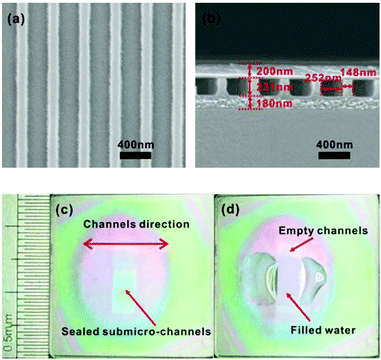
SEM images of the polymer submicro-channels and photographs of the fabricated submicro-optofluidic PGMR filter with empty channels and with water filled channels, respectively.
Optical filters are routinely included in devices used for communications, displays and bio-sensing. One such class of optical filters, which have been frequently used, are guided-mode resonance (GMR) filters. Inherent errors with common GMR filters are assigned to fabrication difficulties and as a result, new classes of reconfigurable GMR filters have been created.
In this HOT article, Jin and co-workers have proposed and devised a novel polymer-based GMR (PGMR) which can be incorporated into lab on a chip devices and become tuned by the optical properties of the fluidic mixture present. The simple and low cost PGMR filter was fabricated in three stages, using two-beam interference lithography, floating nanofilm transfer, and finally, thermal bonding technology.
The tunability of this class of PGMR was tested by filling the fluidic channels with a range of liquid mixtures of differing refractive indices. The resulting PGMR exhibited high reflection efficiency in the visible wavelength region, a narrow band tuning range and a high tuning efficiency. The successful incorporation of the PGMR in an optofluidic device operating in the visible wavelength region opens up the possibility of the inclusion of such PGMR devices in future lab on a chip devices.
A tunable submicro-optofluidic polymer filter based on guided-mode resonance
Guohui Xiao, Qiangzhong Zhu, Yang Shen, Kezheng Li, Mingkai Liu, Qiandong Zhuang and Chongjun Jin
Nanoscale, 2015, 7, 3429-3434. DOI: 10.1039/C4NR07233B.










